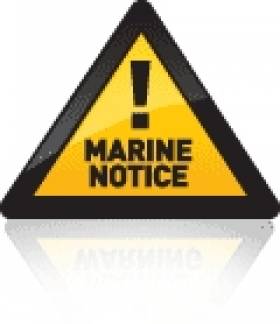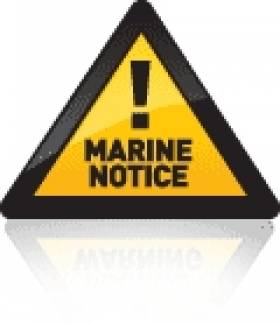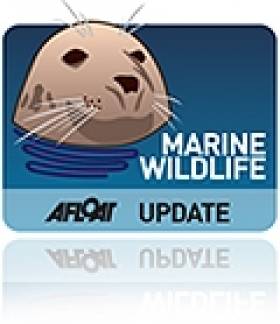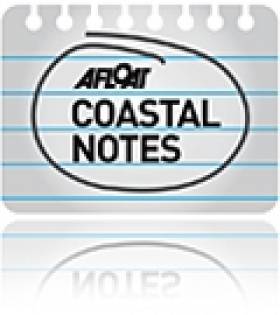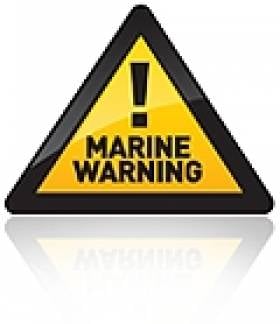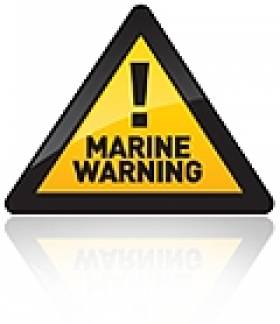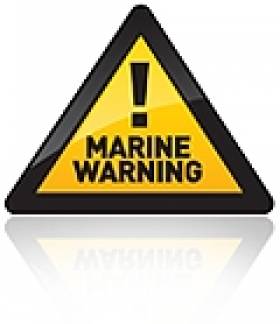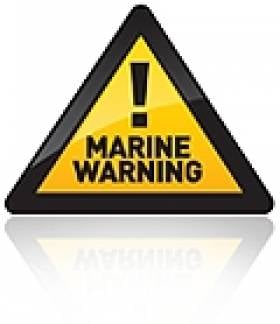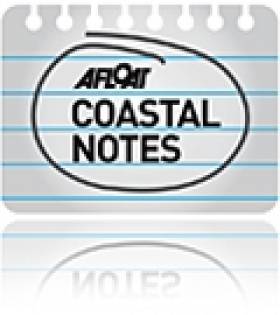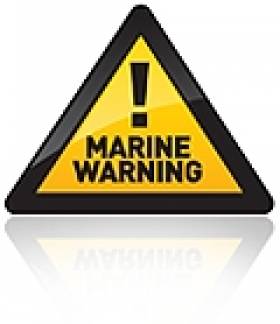Displaying items by tag: seismic survey
Marine Notice: 3D Seismic Survey In South Porcupine Basin
#MarineNotice - The latest Marine Notice from the Department of Transport, Tourism and Sport (DTTAS) advises that Polarcus DMCC is scheduled to carry out a 3D Seismic survey in the South Porcupine Basin off the southwest coast of Ireland.
The survey, similar to the 2D survey in the Porcupine Basin that continues till October, will cover 7,270 km2 and is anticipated to commence in early July with an expected duration of 121 days, subject to weather.
Co-ordinates for the proposed seismic 3D survey are included in Marine Notice No 36 of 2014, a PDF of which is available to read or download HERE.
The seismic vessel M/V Polarcus Amani (Call sign C6ZD3) is scheduled to carry out the work. The vessel will be towing an array of 10 cables, each 8.1km long, with 150m separation for a total width of 1,350m, at a depth of 14 metres.
A buoy equipped with a radar reflector and navigation strobe light will be deployed at the end of each cable.
The seismic vessel will be accompanied by support vessel M/V Bravo Sapphire (Call sign ZDJY8) and chase vessels M/V Nomad (Call sign EI5298) and M/V Ocean Guardian (Call sign EIVX). All vessels will be listening on VHF Channel 16 & 67.
The seismic vessel will be restricted in its ability to manoeuvre while carrying out the survey. All vessels, particularly those engaged in fishing, are requested to give the M/V Polarcus Amani, her towed equipment, the M/V Bravo Sapphire, the M/V Nomad and M/V Ocean Guardian a wide berth and keep a sharp lookout in the relevant areas.
Marine Notice: 2D Seismic Survey In Ireland's Atlantic Waters
#MarineNotice - The latest Marine Notice from the Department of Transport, Tourism and Sport (DTTAS) advises on proposals to complete the 2D seismic survey programme in the Atlantic waters of the Irish Designated Continental Shelf.
The planned start of the survey is mid-April 2014 and, weather permitting, will continue until mid-October 2014.
The programme will commence in the Porcupine Basin till early June and then progress to the Rockall Basin area.
The seismic acquisition will be carried out by the seismic vessel MV BGP Explorer (Call sign HP4919) and will be accompanied by guard/supply vessels MV Neptune 10 (Call sign ZDJQ8) and MV Neptune Mariner (Call sign ZDIW8).
The 2014 programme is proposed to complete the remaining 8,000km survey. The survey vessel BGP Explorer will tow a single solid 10km streamer and will travel at 4-5 knots with the streamer located approximately 10 metres below the water surface.
All vessels will be listening on VHF Channel 16 throughout the project.
All vessels, particularly those engaged in fishing, are requested to give the BGP Explorer, Neptune 10 and Neptune Mariner a wide berth and keep a sharp lookout in the relevant areas.
Details of the relevant survey area are included in Marine Notice No 28 of 2014, a PDF of which is available to read or download HERE.
#MarineWildlife - The Irish Whale and Dolphin Group (IWDG) has welcomed recent measures to protect deep-diving cetaceans from the potential effects of seismic survey noise.
The new measures have been implemented by the Petroleum Affairs Division (PAD) of the Department of Communications, Energy and Natural Resources and the National Parks and Wildlife Service (NPWS).
As a result, the environmental management plan for the 2D seismic survey of the Irish EEZ, being conducted by ENI Ireland BV in conjunction with the PAD, includes the establishment of a 'mitigation zone' along key parts of the continental shelf margin from which all seismic survey is excluded.
The management plan was informed by two projects recently conducted by the IWDG: the recently published Atlas of the Offshore Distribution of Marine Mammals in Irish Waters (funded by the the NPWS and the Marine Institute); and the Beaked Whale Passive Acsoutic Monitoring Pilot, conducted in the Rockall Trough and funded by the PAD.
Both these projects identified areas of the Irish shelf slopes as being of importance to deep-diving cetaceans such as beaked whales, sperm whales and pilot whales.
The mitigation zones implemented during the ENI/PAD 2D survey show how collected data can directly contribute to cetacean conservation in Irish waters, according to the IWDG.
In other news, the IWDG has been carrying out its own survey in North Kerry to investigate the use of Tralee Bay and Bandon Bay by bottlenose dolphins, and assess the potential for marine wildlife tourism in the region.
Since May, Drs Simon Berrow and Joanne O'Brien have ben working with the local community in Fenit and North Kerry to survey and record dolphins and other cetaceans to build up a better understanding of how they use the bays.
The IWDG has also deployed three C-PODs across the bays to acoustically monitor the area for dolphins.
"It has long been known that Tralee and Brandon Bays are the only site where the resident bottlenose dolphins in the Shannon Estuary occur," said Dr Berrow. "The bottlenose dolphins in the Shannon are a genetically discrete population with a relatively small population of around 120-140 individuals. The Shannon is protected for bottlenose dolphins but Tralee and Brandon Bays are not.
"Since the start of this project, which is funded by North and East Kerry Development, we have encountered bottlenose dolphins on every trip. Photo IDs have established them to be Shannon dolphins, and they have been detected acoustically on nearly 90% of days at some sites."
Celtic Mist, the IWDG's research vessel, has been joined by local boats in surveying the area and on Wednesday last (6 August) it encountered a large group of bottlenose dolphins in Brandon Bay - captured on video by local filmmaker James McCarthy:
Minister for Natural Resources, Fergus O'Dowd, has granted approval for the conducting of a major 2D seismic survey that will go a long way towards revealing the true oil and gas exploration potential of Ireland's Atlantic Margin.
"At a cost of €20 million this is is by far the largest regional seismic survey acquired in the Irish offshore, and will provide a regional grid of high-quality seismic data over Ireland's frontier basins," said Minister O'Dowd.
"The 18,000km full-fold seismic survey is also designed to infill data gaps that exist, particularly in the Southern Porcupine, Rockall and Hatton basins.
"Most importantly, the survey should go a long way towards revealing the true oil and gas potential of Ireland's frontier basins.
"The data should allow resource potential to be predicted with much greater confidence and enable both the industry and the Government to adequately evaluate future licensing opportunities."
The survey will be untertaken by ENI Ireland BV in conjunction with the Department of Communications, Energy and Natural Resources in the Atlantic waters of the Irish-designated Continental Shelf.
The survey vessel BGP Explorer is operating from Killybegs and the survey will be conducted for a duration of 145 days. Depending on weather conditions, it is possible that part of the survey will be acquired in 2014.
This is a very large undertaking and Minister O'Dowd indicated that he is pleased that ENI Ireland has agreed to provide strong technical support and operatorship for the survey, with the close involvement of his Department's technical staff. The cost of the research is being jointly funded from the Department's own research funding and funding leveraged from industry.
Marine Notice: 2D Seismic Survey On Continental Shelf
#MarineNotice - The latest Marine Notice from the Department of Transport, Tourism and Sport (DTTAS) advises that ENI Ireland BV, in conjunction with DCENR/PAD, is scheduled to conduct a 2D seismic survey in the Atlantic waters of the Irish Designated Continental Shelf (as defined under Part VI of UNCLOS).
The planned start of the survey is early June and, weather permitting, will continue until mid-October 2013. The seismic acquisition will be carried out by the seismic vessel M/V BGP Explorer (Call sign HP4919) and will be accompanied at all times by guard vessel M/V South (Call sign PJKE).
This proposed survey consists of 18,000km of a full fold 2D seismic survey in offshore waters beyond the 12-nautical-mile limit, and extends into international (high seas) waters.
The M/V BGP Explorer will travel at a speed of 4-5 knots, towing a single solid 10km streamer located approximately 10m below the surface. Both work vessels will be listening on VHF Channel 16 throughout the project.
All vessels, particularly those engaged in fishing, are requested to give the M/V BGP Explorer and the M/V South a wide berth and keep a sharp lookout in the relevant areas.
For co-ordinates of the seismic survey areas see Marine Notice No 25 of 2013, a PDF of which is available to read or download HERE.
#MarineNotice - The busy waters of the Celtic Sea will next month see yet another seismic survey.
Marine Notice No 23 of 2013 advises that Seabird Exploration, on behalf of Spectrum Geo Limited, is scheduled to carry out a 2D seismic survey over the Celtic Basin from the beginning of June till the end of July.
The seismic acquisition will be carried out by the vessel M/V Harrier Explorer (Call sign 3EIE3), which will be accompanied at all times by guard vessel M/V Nomad (Call sign EI5298).
The proposed survey consists of 3,570km of a 2D seismic survey over the Celtic Basin. The survey vessel will travel at 4-5 knots, towing a single solid 8km streamer located some 9 metres below the surface, with a turning diameter of approximately 5km required.
Both vessels will be listening on VHF Channel 16 throughout the project. All vessels, especially those engaged in fishing, are requested to give them a wide berth and keep a sharp lookout in the relevant areas - the co-ordinates of which are outlined in the PDF available to read or download HERE.
Marine Notice: 3D Seismic Surveys In Celtic Sea
#MarineNotice - Further to the recent notice of a 2D seismic survey in the Atlantic waters of the Irish continental shelf, Marine Notice No 14 of 2013 advises mariners of two full 3D seismic surveys in the Celtic Sea off the south coast.
CGG will be conducting the surveys on behalf of Fastnet Oil & Gas as part of its option on the Deep Kinsale Prospect, as previously reported on Afloat.ie.
The works are expected to commence in later this month and are expected to last around 50 days, subject to weather, beginning with the Deep Kinsale survey followed by the Mizen survey.
The seismic vessel SR/V Vantage (Call sign LMHY3) is scheduled to carry out the work. The vessel will be towing 10 cables, each 6km long with 100m separation for a total width of 900m, at a depth of seven metres. The vessel will also tow two source arrays, each made of three subarrays, each with a width of 16m and at a depth of six metres.
The seismic vessel will be accompanied by support vessel M/V Oms Resolution (Call sign HP5135) and chase vessel M/V Stormbas II (Call sign V4EM2).
In addition, as part of the Deep Kinsale survey, a second 3D seismic vessel M/V Artemis Angler (Call sign LAGU7) will assist in an undershoot of the Kinsale Alpha and Bravo platforms. The two 3D seismic vessels will sail in parallel at the same speed, one on each side of the platforms using streamers. The undershoot aspect of the acquisition is expected to last two to three days.
The seismic vessels will be restricted in their ability to manoeuvre whilst carrying out the surveys and all other vessels are requested to give these operations a wide berth. All project vessels will be listening on VHF Channel 16 throughout the project.
All vessels, particularly those engaged in fishing, are requested to give the SR/V Vantage, the M/V Artemis Angler and their towed equipment a wide berth and keep a sharp lookout in the relevant areas.
Full details of co-ordinates of the survey areas are included in Marine Notice No 14 of 2013, a PDF of which is available to read or download HERE.
Marine Notice: New Seismic Survey Of Continental Shelf
#MarineNotice - The latest Marine Notice from the Department of Transport, Tourism and Sport advises mariners that ENI Ireland BV is scheduled to conduct a 2D seismic survey in the Atlantic waters of the Irish Designated Continental Shelf.
The planned start of the survey is mid-April 2013 and, weather permitting, will continue until mid-October 2013.
The proposed survey consists of 18,000km of a full-fold 2D seismic survey in offshore waters beyond the 12-nautical-mile limit, and extends into international (high seas) waters.
The seismic acquisition will be carried out by the seismic vessel M/V BGP Explorer (Call sign HP4919), which will be accompanied at all times by guard vessel M/V Alk Explorer (Call sign HO2639). In addition, M/V De Vrouw Marie (Call sign HP9974) will act as a supply vessel for the re-supply of materials.
M/V BGP Explorer will tow a single solid 10km streamer. The vessel will travel at 4–5 knots and the streamer will be located approximately 10 metres below the surface. All vessels will be listening on VHF Channel 16 throughout the project.
The notice requests all vessels, particularly those engaged in fishing, to give the M/V BGP Explorer, the M/V Alk Explorer and the supply vessel a wide berth, and keep a sharp lookout in the relevant areas.
Details of co-ordinates for the seismic survey are included in Marine Notice No 13 of 2013, a PDF of which is available to read or download HERE.
Notice of this latest seismic survey comes after the news that the European Commission has sought an explanation from the Government over why it has not conducted environmental impact assessments for such operations in Irish waters, which are a designated whale and dolphin sanctuary.
Meanwhile, another recent Marine Notice advises passenger ship operators of the requirements for vessels engaged in the tendering of passengers between ship and shore.
Full details on the relevant provisions of the Merchant Shipping Acts are included in Marine Notice No 12 of 2013 available HERE.
Brussels Wants Answers From State Over Seismic Surveys
#SeismicSurvey - The Irish Times reports that the European Commission has demanded an explanation from the State regarding the absence of environmental impact assessments for seismic surveys off the west coast.
The action comes following a complaint lodged in Brussels by the Irish Whale and Dolphin Group (IWDG) in the wake of the recommencing of seismic surveys over the Corrib gas field last month.
As Irish waters are a designated whale and dolphin sanctuary, the IWDG's position is that the State must comply with the EU directive to conduct an environmental impact assessment when licensing such ocean-bound surveys.
The group says it received word from the EC that the issue has been raised with the Department of Energy, and reiterated the need for "strict protection" of cetaceans in Irish and all EU waters.
Last December the IWDG expressed concerns over the potential impact of a 2D seismic survey on harbour porpoises in the Kish Bank Basin in Dublin Bay.
As previously reported on Afloat.ie, Providence Resources subsequently suspended its licence to explore for oil and gas at what was termed the Dalkey Island Prospect.
The Irish Times has more on the story HERE.
Marine Notice: Corrib Field Seismic Survey Set to Recommence
#MarineNotice - The latest Marine Notice from the DTTAS concerns the scheduled recommencing of a 3D seismic survey over the Corrib Gas Field by Shell E&P Ireland Ltd.
Some 40% of the survey was completed in 2012, and the remaining 60% is now set to be conducted with a planned starting date of 20 February 2013. Weather permitting, the survey should be completed in June 2013.
The seismic acquisition will comprise a four-boat operation. The M/V Ocean Pearl (Call sign C6ZW4) will lay the ocean-bottom cables on the sea floor and will collect all data records, while the M/V Malene Ostervold (Call sign LCIU3) will serve as the source vessel. In addition to these vessels, a third vessel, the M/V Vikland (Call sign C6UL5) will assist the M/V Ocean Pearl with cable laying and also act as a utility vessel. A fourth vessel, the M/T Deilginis (Call sign EISL), will act as a guard wessel.
Seismic acquisition will occur over a set of four active 12km-long solid ocean-bottom cables laid 400m apart on the sea bed at a depth of 350m. At the end of each cable is a 1km lead-in section which is attached to a standalone buoy at surface. These buoys contain a power pack as well as a recording system. Each buoy contains a radio-link with the cable-laying vessel for remote control of the buoy and for data quality control. Each buoy has a GPS receiver, so its location is well known to both seismic vessels. One by one these cables are 'rolled along' (ie picked up from the northern edge of the active spread, and redeployed at the southern edge). The M/V Malene Ostervold will be towing two seismic sources, and operating around the set of four active 12km-long cables.
The overall survey area is divided into three work areas or Contact Zones (A, B and C). A Contact Zone is defined by a 10km radius circle. Radio Navigation Warnings will be given out daily by the Irish Coast Guard, giving the co-ordinates of the centre point of the Contact Zone for that day. All vessels will be listening on VHF Channel 16 throughout the project.
Full details - including co-ordinates and maps of the survey area - are contained in Marine Notice No 07 of 2013, a PDF of which is available to read or download HERE.



























